settings
children
With Famly since
Space activity 1: Find out why the moon has craters
Activity source: We Are Teachers

The space activity in a nutshell:
What are craters, exactly? And how come the moon has got so many of them? Learning about space is always fun! This sensory lesson is a great bit of excitement for children, and helps them understand what gives the moon its pockmarked look.
What you will need:
- Flour
- Small pebbles or rocks
- Round cake pan
How to do it:
Fill the bottom of a round cake pan with a layer of flour. You can sprinkle a bit of dirt or sand in here too, to give it a bit of texture. Place the round cake pan on the floor, and tell the children that this is the moon. Each child has a few pebbles in hand, and one by one, they can take turns to drop their pebbles into the flour. With help from the little hands, take the pebbles out of the flour carefully and gently, and point out the crater-like indents. You can also talk about why we haven’t got the same marks all over the earth, as our atmosphere burns up most meteorites.
Space activity 2: Bake some sparkly space rock buns
Activity source: Rainy day mum
The space activity in a nutshell:
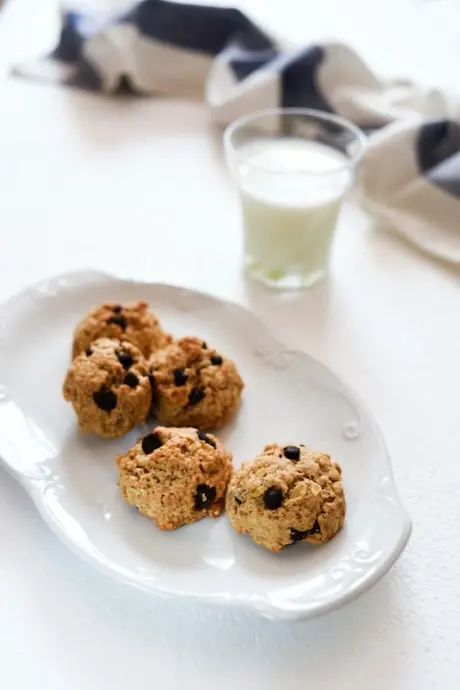
Learning about space can be delicious! You can bake these sparkly space rock buns yourself, or make them together with children. Combined with other space activities, these buns are the perfect fuel for aspiring astronauts.
What you will need:
- 100g butter
- 200g plain flour
- 2 tsp baking powder
- 75 g brown sugar
- 125 g raisins, or other dried fruit
- 1 medium egg
- 2 tbsp milk
- Edible glitter
- Gold and silver food dust
How to do it:
Add the flour and baking powder to the butter, and show the little kitchen helpers how to blend the mixture with their fingers. While they’re helping with that, add in the brown sugar and raisins. Now, children can start to mix while an adult beats the egg and pours it into the mixture. Get messy and allow everyone to have a turn to stir the mixture and add a little milk until you have a consistency similar to cookie dough, this is also a great time to add your edible glitter. Now you can roll or clump together pieces of dough to form rock shapes, you should have enough to form 6 large buns or 12 small ones. Bake them at 180 degrees for around 20 minutes before allowing them to cool. Grab a bun and blast off!
Space activity 3: Create stargazing bottles
Activity source: Pre-K Pages
The space activity in a nutshell:

Here’s a little razzle-dazzle sensory fun that is as beautiful as it is fun to touch. The star gazing bottle recreates a miniature version of a beautiful starry sky, giving you a sensory toy that inspires little ones to wonder about what they’ll find in outer space.
What you will need:
- 500ml plastic water bottle, or another clear container
- 1 1/2 cups warm water
- Black glitter glue
- Star sequins
- Gold glitter, fine and superfine (optional)
- Clear hand soap (optional)
- Superglue
How to do it:
Stir the warm water into the black glitter glue in a large measuring cup. Fill the bottle 3/4 full with the glue and water mixture, and have your little helpers sprinkle some of the star sequins into the bottle. Close the lid of the bottle and shake it — you’ll see the glitter swirl beautifully. To make it move even faster, add a few drops of clear hand soap. To make it move slower, you can top it off with additional clear glue. Once you are happy with your mixture, seal the top closed permanently with super glue. Show the children how to hold it up to the light and shake it around to make the glitter swirl. It's absolutely mesmerising!
Space activity 4: Make your own telescope
Activity source: In the playroom

The space activity in a nutshell: Boxes, empty kitchen rolls and other ordinary household packaging items often make the most entertaining toys because they still leave room for the imagination. This activity piggy-backs on children’s natural love for open-ended, imaginative play - what better way to see the planets in our solar system?
What you will need:
- Cardboard kitchen rolls
- Coloured tissue paper
- Sello tape / clear tape and scissors
- Foam stickers and cutout shapes
How to do it:
Cut the tissue paper to be the same length as the kitchen roll, and wrap the paper around so that it fully covers the kitchen roll tube. Tape it down firmly to secure it in place. Have your decorations set out in little bowls, so that the children are able to choose what they want with ease. Show them how to use the glue safely by applying it to the foam sticker or cutout shape, and then applying the decal to the roll. Once the rolls have all been decorated beautifully, allow them some time to dry before they’re included in free play games or activities. They’re a great prop to let your little astronomers dive into the creative world of exploring space!
The big ideas

Space activity 5: Make a squeezy rocket ship launcher
Activity source: Rainy day mum
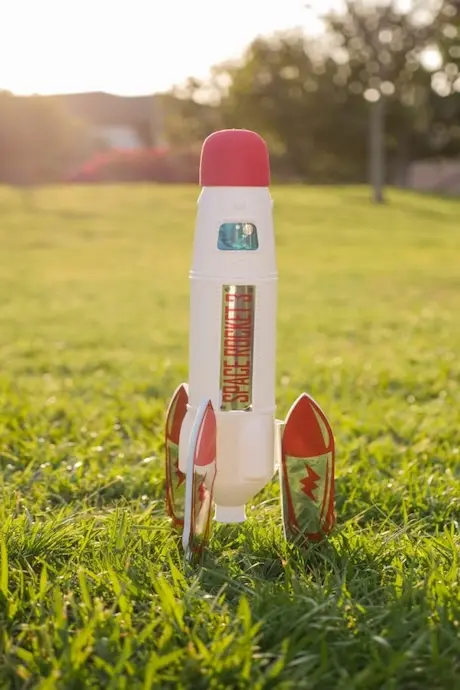
The space activity in a nutshell:
This fun experiment is all about space travel, discovering how different angles affect the way the rocket launches. Using some recycled materials, you can launch rockets over and over to discover the best angle for launch by observing how it flies.
What you will need:
- Empty squeezy water bottles with a sports cap
- Cardboard
- Two different widths of drinking straws
- Scissors
- Glue/sellotape
- Blu tack or Plasticine
How to do it:
Lift up the bottle’s cap and push your thinner straw halfway down inside. Seal the space around the straw by packing plasticine around it, or using glue. Test your seal by squeezing the bottle — you should only feel air coming out of the straw. Now seal up one end of your thicker straw, using tape and glue to ensure no air escapes from the sealed side. Children can draw and cut out a cardboard rocket and attach it to that sealed thicker straw with double-sided tape. The thicker straw should fit onto the thinner straw, thereby placing the rocket on your bottle/launch pad. With a good hard squeeze, you have liftoff! Point the rocket in different directions to see if it flies better when positioned sideways, upwards, or downwards.
Space activity 6: Craft a moon phases spinning toy
Activity source: Happy to shelf

The space activity in a nutshell: This toy makes for an interactive little demonstration of the different moon phases.
What you will need:
- 2 large clear plastic cups
- Black permanent marker pen
- 1 yellow circle, it can be a sticker or yellow paper
- A piece of black construction paper
- Glue
- Tape
- Ruler
How to do it:
Cut a rectangular piece of black construction paper to be as tall as your cups. Stick the yellow circle on the black construction paper, to show the bright side of the moon. Roll the paper up, and put it into the cup and secure it with tape or glue — you should have a blacked-out cup, with one yellow circle facing out. This cup now goes into the second cup. Then, using a black marker, colour in different phases of the moon on the outer cup. This way, as you turn that inner cup, you’ll move the yellow circle to be covered by the different markings, making an interactive map to explore how the moon changes as it orbits our earth.
Space activity 7: Make a space sensory bin
Activity source: Pre-K Pages
The space activity in a nutshell:
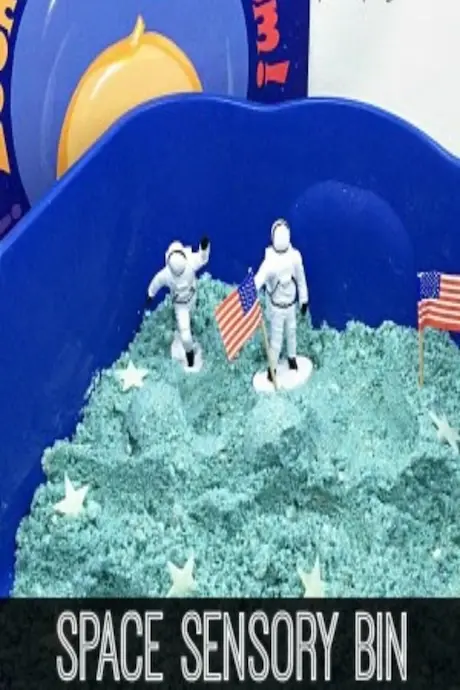
Sensory play invites children to explore textures, stretch their imaginations, and build up their motor skills. With a space-themed sensory bin, you can encourage children to process all that outer space learning through self-guided play. Why not add some space books to extend their learning?
What you will need:
- 12 cups play sand
- 6 cups corn starch
- 8 tablespoons coloured powder paint
- 3 cups water
- Silver glitter to your liking
- Space-themed toys and figurines
- A tuff tray or similar tub or tray container
How to do it:
Add the play sand to your container along with corn starch and the powder paint. Finally, add the water and silver glitter and mix it all up. You can invite the children to help you mix the ingredients together and squeeze out any lumps. Now you can add in a few space figurines, glow-in-the-dark stars, large pebbles, or any other items you might want. The children’s natural curiosity and imagination will take over, and they’ll enjoy digging in the glittering sand and creating space scenes.
Space activity 8: Craft a space helmet from a cardboard box
Activity source: rainy day mum
The space activity in a nutshell:
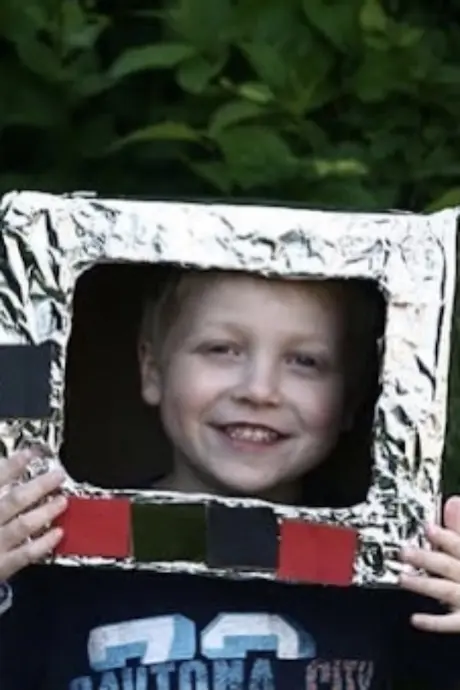
Every space explorer needs a helmet! This space helmet encourages imaginative play, inviting little learners to really think about what they have learned about space, and to put themselves in an astronaut’s shoes (or moon boots).
What you will need:
- Aluminum foil
- Glue
- Coloured paper
- Cardboard cutouts - stars, planets, suns, moons
- Cardboard boxes large enough to fit over a child’s head
How to do it:
Cut a large hole in one side of the box, to use as the helmet’s viewport. Covering all sides of the box with glue, apply a layer of foil to turn your box into a shining bit of space tech. Once this is done, children can use some of the cutouts and shapes and stick them around the visor as decorations. Leave the helmets to dry for an hour or two before using them. One of the greatest ways to start children on a game is to first read a space story! You can encourage your children to act out the storyline and repeat what they know about space.
Space activity 9: Easy torn paper planets
Activity source: 3 Dinosaurs
The space activity in a nutshell:
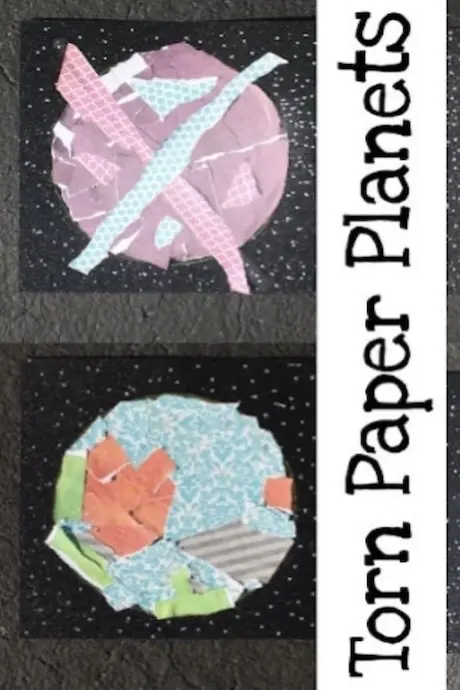
This artistic, open-ended activity with a fun space theme also helps little ones develop fine motor skills, and gives children a very personal work of art to take home and share.
What you will need:
- Crayons
- Paper plates
- Black glittery cardstock
- Scrapbooking paper
- Glue sticks
- White paint markers
How to do it:
Use the paper plates as a template, and mark out a circle outline on your black background paper. Now each child can choose their favourite scrapbooking paper, a variety of colours and crafts, and fill in that circle to create the colourful surface of their own fantasy planet. Tear up pieces of scrapbooking paper and stick the torn pieces down onto the black glitter paper, which makes the perfect space backdrop. Everyone can decide for themselves how their planets might look, and you can talk about why planets look the way they do. Why have some got rings around them? Is your planet hot or cold? What colour is the surface, and what’s it made of? At the end, you’ll have your own solar system built from your children’s imaginations.
Please note: here at Famly we love sharing creative activities for you to try with the children at your setting, but you know them best. Take the time to consider adaptions you might need to make so these activities are accessible and developmentally appropriate for the children you work with. Just as you ordinarily would, conduct risk assessments for your children and your setting before undertaking new activities, and ensure you and your staff are following your own health and safety guidelines.
Get 1000s of free EY activities
Want over 7,000 activities? See them in a free 14-day trial. Filter to target learning areas, age groups and topics, and get inspired.
Get started









